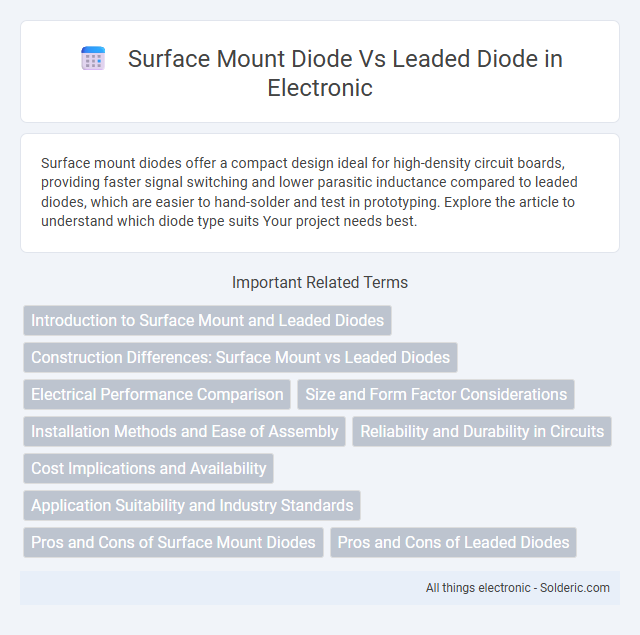Surface mount diodes offer a compact design ideal for high-density circuit boards, providing faster signal switching and lower parasitic inductance compared to leaded diodes, which are easier to hand-solder and test in prototyping. Explore the article to understand which diode type suits Your project needs best.
Comparison Table
| Feature | Surface Mount Diode (SMD) | Leaded Diode |
|---|---|---|
| Size | Compact, small footprint | Larger, bulkier |
| Mounting Type | Surface mount technology (SMT) | Through-hole technology (THT) |
| Assembly | Automated pick-and-place machines | Manual or wave soldering |
| Thermal Performance | Good heat dissipation via PCB | Higher thermal mass in leads |
| Electrical Performance | Low parasitic inductance and capacitance | Higher parasitic effects |
| Mechanical Strength | Less strain tolerance on PCB flex | More robust leads for bending and handling |
| Applications | High-density circuit boards, mobile devices | Prototyping, high-power, or mechanical stress environments |
| Cost | Lower per unit in large volumes | Higher cost for manual assembly |
Introduction to Surface Mount and Leaded Diodes
Surface mount diodes are compact semiconductor devices designed for direct placement on printed circuit boards (PCBs) without leads, offering higher component density and better performance in high-frequency applications. Leaded diodes, also known as through-hole diodes, feature wire leads for insertion into PCB holes, providing robust mechanical strength and easier manual soldering, ideal for prototyping and low-volume productions. Choosing between surface mount and leaded diodes depends on your design requirements, including size constraints, manufacturing processes, and environmental conditions.
Construction Differences: Surface Mount vs Leaded Diodes
Surface mount diodes feature compact, flat packages designed for direct placement on printed circuit boards (PCBs), enabling automated assembly and reduced board space usage. Leaded diodes have wire leads extending from their bodies, facilitating manual insertion into through-hole PCB holes and providing stronger mechanical connections for high-reliability applications. Understanding the construction differences helps you select the ideal diode type based on assembly method, space constraints, and mechanical durability needs.
Electrical Performance Comparison
Surface mount diodes exhibit lower parasitic inductance and capacitance compared to leaded diodes, resulting in faster switching speeds and improved high-frequency performance. Leaded diodes generally have higher thermal resistance, which can limit their efficiency in high-power applications, whereas surface mount types offer better heat dissipation due to their compact size and direct PCB contact. Electrical noise and signal integrity are enhanced in circuits using surface mount diodes, making them preferable for high-speed and high-frequency electronic designs.
Size and Form Factor Considerations
Surface mount diodes offer a significantly smaller size and lower profile compared to leaded diodes, making them ideal for compact and densely packed electronic circuits. Their form factor allows for automated placement and soldering, enhancing manufacturing efficiency and reducing overall assembly costs. Choosing surface mount diodes helps optimize your device's space and supports high-density PCB designs without sacrificing performance.
Installation Methods and Ease of Assembly
Surface mount diodes are designed for automated pick-and-place machines, enabling high-speed, precise placement directly onto PCB pads, which significantly reduces manual labor and assembly time. Leaded diodes require through-hole mounting, involving manual or wave soldering processes that are generally slower and less compatible with automated assembly lines. The compact form factor and soldering ease of surface mount diodes streamline mass production and contribute to improved manufacturing efficiency.
Reliability and Durability in Circuits
Surface mount diodes offer higher reliability and durability in circuits due to their smaller size, which reduces parasitic inductance and enhances thermal performance. Their robust construction allows better resistance to mechanical stress and vibration compared to leaded diodes, making them ideal for applications with frequent temperature changes or physical impact. You benefit from longer operational life and improved circuit stability when choosing surface mount diodes over traditional leaded types.
Cost Implications and Availability
Surface mount diodes generally offer lower manufacturing costs due to automated assembly and smaller size, allowing for higher production volumes and reduced material expenses. Leaded diodes, while often more expensive due to manual handling and bulkier packaging, are widely available and preferred in prototyping and repair scenarios for easier manual soldering. Your choice between these diode types should consider both cost efficiency for large-scale production and availability tailored to your project's assembly methods.
Application Suitability and Industry Standards
Surface mount diodes offer superior application suitability for modern electronics due to their compact size and compatibility with automated assembly processes, meeting strict industry standards for miniaturization and reliability. Leaded diodes, favored in applications requiring easy manual handling and prototyping, conform to established industry standards for through-hole components, ensuring robust mechanical stability. Your choice between the two depends on the specific assembly method, space constraints, and regulatory requirements of your electronic design.
Pros and Cons of Surface Mount Diodes
Surface mount diodes offer significant advantages such as smaller size, allowing higher component density on PCBs and improved high-frequency performance due to reduced lead inductance. However, they can be more challenging to handle and solder manually, requiring specialized equipment and making repair or replacement less convenient compared to leaded diodes. Your choice depends on priorities like space-saving and automated assembly versus ease of prototyping and repair.
Pros and Cons of Leaded Diodes
Leaded diodes offer easy handling and reliable mechanical strength, making them ideal for prototyping and repair in through-hole PCB applications. Their larger size allows for better heat dissipation but limits placement density compared to surface mount diodes. Your choice depends on whether ease of manual assembly or compact design takes priority in your project.
Surface mount diode vs Leaded diode Infographic

 solderic.com
solderic.com